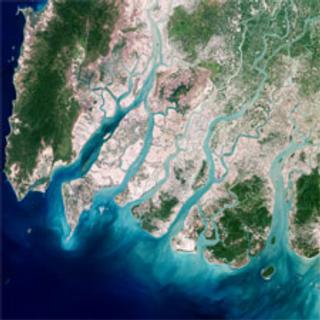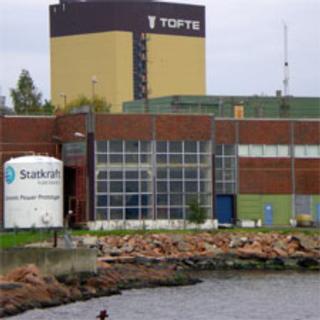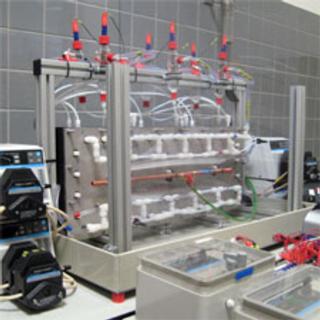
Energy Out of the Blue: Generating Electric Power from the Clash of River and Sea Water
Two pilot projects are testing the potential of "salt power," a renewable energy that relies on the differing salinities at river mouths to make watts
Oct 19, 2009 - Adam Hadhazy - Scitific American
 |
ELECTRIC BLUE: New projects aim to generate energy by harnessing the salinity-balancing effects where freshwater rivers flow into salty seas.
© NASA/ROBERT SIMMON |
In the hunt for alternatives to polluting and climate-warming fossil fuels, attention has turned to where rivers meet the sea. Here, freshwater and saltwater naturally settle their salinity difference, a phenomenon that two pioneering projects in Europe will try to harness to generate clean energy.
This concept of "salt power"—also known as osmotic, or salinity-gradient, power—has been kicked around for decades, and now, proponents hope, technology has advanced enough to make it economically competitive.
 |
PILOT PLANT: This prototype facility built by the Norwegian utility Statkraft will test out a form of electricity generation that relies on freshwater osmotically flowing into saltwater to build pressure.
© STATKRAFT |
On November 24, the world's first large-scale prototype facility for developing a form of salt power called pressure-retarded osmosis is expected to begin fully operating in Norway. "The big reason to build this thing is to answer important questions [about osmotic power], and while we've done a lot of theoretical studies, we need live experience," says Stein Erik Skilhagen, vice president of osmotic power at Statkraft, Norway's state-owned power utility that built the plant. The prototype will have no customers, although the very small amount of electricity it generates will technically be directed into the power grid.
Statkraft's approximately $5-million prototype plant is a converted paper mill in the seaside village of Tofte, about 60 kilometers south of Oslo. The plant's pressure-retarded osmosis setup will place freshwater and brine on either side of a semipermeable membrane that prevents the passage of salt particles but allows water through. Water from the fresh side naturally flows into the salty side, generating pressure equivalent to a column of water 120 meters high. This pressurized water can be used to turn a turbine to make electricity. Statkraft's goal is to yield five watts per square meter of membrane, although current capacity is about three watts. If successful, the utility hopes to build a commercial salt power plant for paying customers around 2015 with a targeted cost ranging from seven to 14 cents per kilowatt-hour (pdf) (at current euro–dollar conversion rates), which at the low end would be competitive with coal and natural gas prices.
 |
H2O ENERGIZER: A desktop setup of the "blue energy" concept, which essentially is a saltwater and freshwater battery, being developed in the Netherlands.
© WETSUS/JOOST VEERMAN |
To the south in the Netherlands, a Dutch research firm called Wetsus has fired up its own salt power experiment to evaluate what is essentially a saltwater–freshwater battery.
Wetsus, with the collaboration of a spin-off company called Redstack, is pursuing a version of salt power dubbed "blue energy". A pilot-scale installation that is about two times the size of a big American refrigerator is up and running in Harlingen, by the Wadden Sea, says Gert Jan Euverink, Wetsus's deputy scientific director. The technology relies on reverse electrodialysis, wherein a series of fresh and saltwater streams are diverted via underground pipes to opposite sides of two kinds of membranes. These let sodium or chlorine ions—the constituent elements of salt—dissolved in the water to pass into separated freshwater streams. This builds an electrical potential across the membranes, like a battery, and this charge reacts with iron to form an electric current. Joost Veerman, a researcher at Wetsus, says the company aims to get five watts per square meter of membrane, the same result as Statkraft's process.
Neither Statkraft nor Wetsus expects to crank out more than just a few kilowatts—enough to boil water—with their initial experiments. Instead, they plan to demonstrate what could be scalable, commercially viable energy production as well as determine if salt power endangers the health of source-water estuaries. Statkraft estimates salt power's worldwide electricity-generating potential at up to 1,700 terawatt-hours, or about 10 percent of global demand.
Salt power is attractive for several reasons: For one, unlike renewable energy technologies for harvesting solar or wind power, salt systems are not dependent on the weather and could provide baseload (constant, predictable) electricity like that supplied by coal, natural gas and nuclear energy. "The river water is flowing into the sea 24/7, so you have a constantly available source of energy," Skilhagen says. He also points out there are no emissions besides brackish water, which swirls in the river's mouth anyway.
Unlike conventional hydropower, a saline power plant does not require damming off a waterway, and it may require less infrastructure than, say, riverbed-mounted turbines or floating fleets of generators for equivalent tidal and wave power. A salt power plant, including its membrane stacks, turbines, cleaning facilities and offices, could actually be located in a riverside industrial complex's basement, for example, or constructed underground within a riverbank with pipes extending into the waterway, Statkraft's Skilhagen says—a big advantage for incorporating such facilities into already-developed, populated coastal areas.
Membrane design and performance remain the biggest hurdles for both Statkraft's and Wetsus's approaches. The membranes must be made more efficient, durable and resistant to microbial buildup, or so-called biofouling. Pretreating the pumped-in water by filtering out organic matter and river-borne debris helps, but this critical step consumes energy and is expected to be expensive, Skilhagen says, adding that it is too early to know just how expensive.
Accordingly, experts remain cautious about salt power's prospects. "Both these methods are promising and certainly worth researching," says Ari Seppala, a mechanical engineer and thermodynamicist at the Helsinki University of Technology in Finland, "but both may still need a breakthrough innovation before commercialization." Seppala sees no physical or chemical showstoppers standing in the way of producing much-improved membranes, although he also points out that a better, membrane-free method could yet be found for exploiting salinity differences to yield electricity.
Another key uncertainty: a salt-power plant's effect on the local aquatic environment. "This is a completely new process that has not been tested on this scale," says Menachem Elimelech, a professor of chemical and environmental engineering at Yale University. "I doubt there will be no [environmental] impact at all." If the ecological footprint is minimal and the membrane technology advances, however, he adds that salt power could be a "significant renewable energy option."

|





